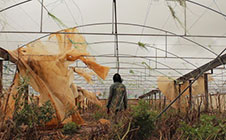|
|
|
Unslept
|
 |
I once read a meditation on cinema which mused that
whenever, in a film, the camera concentrates on a blank, white sheet – usually
bedsheet or table cloth, perhaps hanging on a clothes line in the wind – it’s
possible to witness the birth (or strategic rebirth) of the medium itself: born
flickering from pure whiteness into the first traces of fiction. Michelangelo
Antonioni (in Identification of a Woman,
1982), Philippe Garrel (Liberté, la nuit,
1984) and Jean-Luc Godard (La femme
mariée, 1964) are among the directors who have given us this exact vision
and sensation: think of those de-individualised hands sliding on and off the
crisp sheets that fill an otherwise featureless frame …
The idea returns to mind while watching the fifteen,
black-and-white minutes of Allison Chhorn’s Unslept – with the difference that, this time, the sheets are always crumpled, lived in,
disarrayed. Just like the human flesh that is glimpsed in immaculately
decentred frames: creased, wrinkled, worried (in the way that one actively “worries” a talismanic object). Chhorn always
seems to begin her work from the slight or vague tremor of something that is disturbed: a life, a place, a
relationship, a situation.
As in the films, videos and installations of Apichatpong
Weerasethakul (an admired reference point for Chhorn), these primordial or
historic disturbances are picked up on, followed along, and perhaps, ever so
slightly, ironed out in the course of a semi-fictive/semi-documentary
audiovisual montage with its sympathetic resonances and poetic correspondences.
Here we trace, in particular, the action of fingers:
tapping, twisting, typing. As in her Last Time (2018), the images are carefully deframed; off-screen space haunts whatever
is on-screen; focus is shifted from clarity to blur (or vice versa) and back; and
the soundtrack is a pleasing bed of atmospheres and noises: birds, passing
cars, the running water of a shower.
There’s a trace of Chantal Akerman’s Je tu il elle (1974) in the basic set-up
here: a woman in her room, trying to sleep, receiving phone messages …
Something may have recently ended in the past; someone may be coming over in the
present: it’s hard to tell, and it’s not finally important to know. What Chhorn
works on is the fine, formal suspense of waiting:
time passes, small gestures accumulate, and the body angles itself variously in
relation to wall, corners, sheets, pillows – accommodating itself to a space
that it seems both controlling of and controlled by. As Bérénice Reynaud once
said of Akerman’s film (and of Éric Rohmer’s Full Moon in Paris [1985]: a woman’s “room of her own” is also the
space that dispels her, alienates her, keeps her in a mild state of hysterical
agitation …
|
The Plastic House
|
 |
The Plastic House is the most
demanding of Chhorn’s films to date – demanding of our attention and
concentration over a slowly unwinding span of 45 minutes. It’s easy to tag its
style and manner with labels like minimalism and slow cinema but, as usual,
what Chhorn does inside this broad framework is distinctive and detailed. It
elaborates an intermingling of documentary and fiction elements that (the
director has stated) is not strictly autobiographical, but involves elements
drawn from her lived experience. In particular, several fugitive details point
to the significance for the filmmaker of her mother’s and father’s involvement
and influence.
It’s hard to decipher the narrative thread, beyond the
fact that there’s a greenhouse – covered in plastic – that needs to be tended
(mostly by a single individual: Chhorn herself), and which may be a family
business. Snatches of conversation are laid into the soundtrack, which (as is
typical of Chhorn) is mainly a fine-grain rendering of acoustic atmospheres and
tones. The greenhouse itself is a riot of vertical structures, framed either as
a disorienting tangle (again, some masterful work with sharpness and blur), or
in relation to the horizontal tracks of the lines of plants. Mood is
all-important here, taking prominence over narration in any strict sense.
Yet there is still a certain kind of narrative
development at work; I was reminded of Vivi Tellas’ fertile idea (in modern “Reality
Theatre” practice) of a “Minimal Threshold of Fiction”, involving another kind
of readily available-to-hand documentary/story intermeshing. Like in Chantal
Akerman’s classic Jeanne Dielman … (1975), the absorption in everyday duties and gestures of work creates its own,
unusual kind of tension – as well as its own unfolding drama. Early glimpses of
cracks in a wall and a tear in the plastic, and early periods of mild rain,
prepare the way for a full-on storm that appears to wreak devastation upon at
least part of the greenhouse: the plants and the plastic equally decimated and
whisked away.
Throughout all this, there are glimpses of the central
female figure (never filmed in full-face close-up, always turned away,
decentred, fragmented into body parts) in her room – during the storm, covering
her books and DVDs with plastic – and in a car: two “species of spaces”,
interior and private, that recur in Chhorn’s work (as in Unslept and Last Time). Which
of these visible and felt structures, finally, is the “plastic house” of the
title? Greenhouse, room or car? Probably all of them,
poetically. Sleeping, waking, dreaming, driving, walking, working: all tend to
swim together in The Plastic House,
as underlined by a filmed quotation from William Faulkner’s As I Lay Dying about being “emptied for
sleep”.
© Adrian Martin November 2018 |
![]()